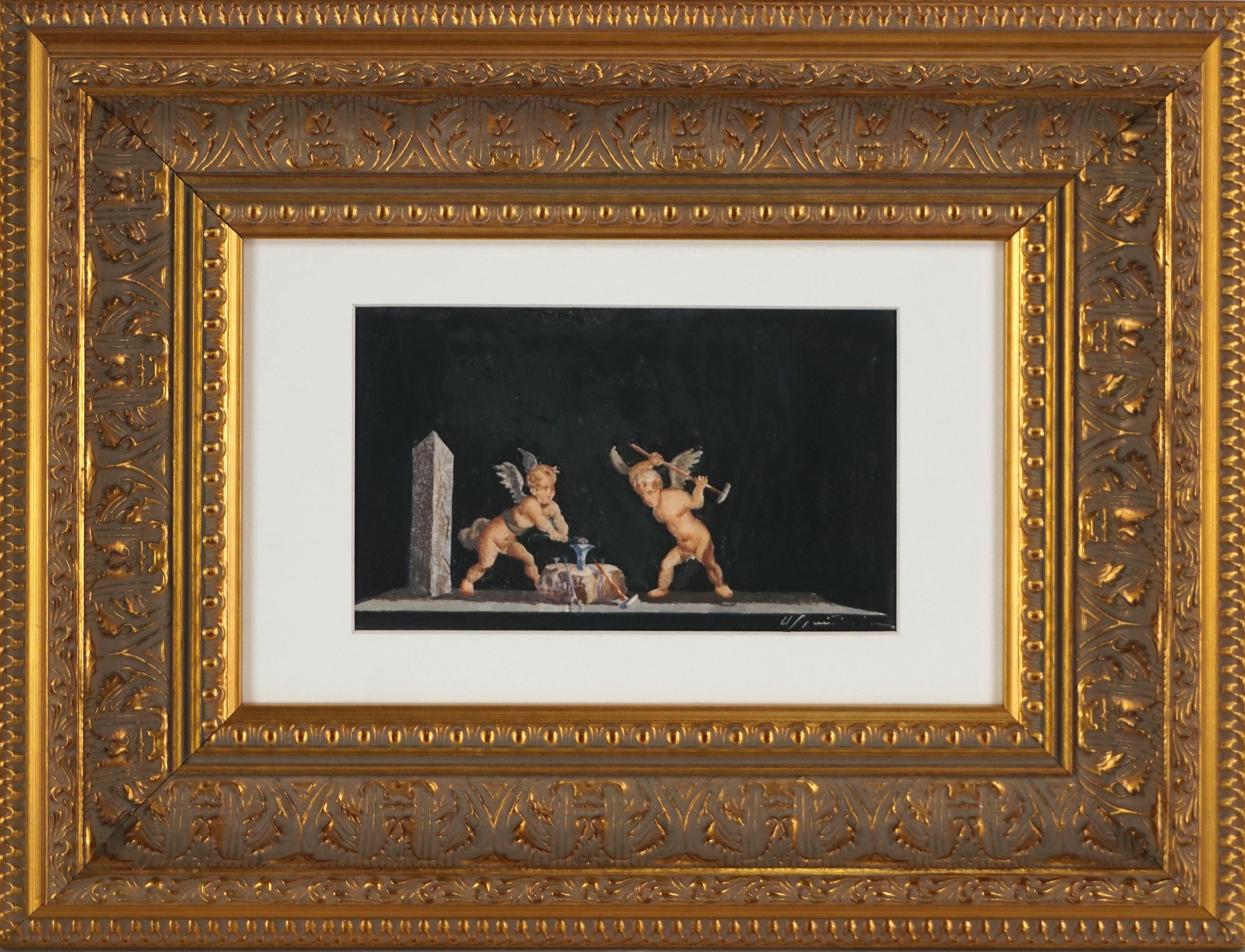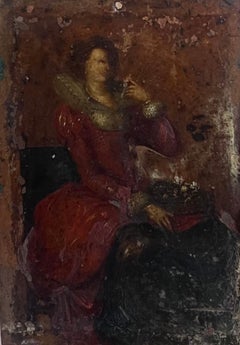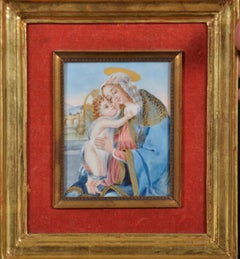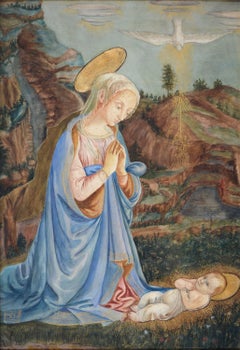Questions & Answers
Our trusted network of 1stDibs sellers answer common questions
How many paintings did Raphael do?
1 Answer

No one knows for certain how many paintings Raphael did. Art historians believe that the Italian Renaissance artist likely produced around 500 works over the course of his life, but the exact number hasn't been determined. Some of Raphael's most famous paintings include The School of Athens, The Sistine Madonna, The Transfiguration and The Marriage of the Virgin. On 1stDibs, shop a variety of Renaissance paintings.
1stDibs ExpertFebruary 27, 2024
Related Questions
- How many paintings did Michelangelo paint?1 Answer
- How many paintings did Modigliani paint?1 Answer
- How many paintings did Dalí do?1 Answer
- How many Renoir paintings are there?1 Answer
- How many paintings did Kandinsky paint?1 Answer
Shop for Renaissance Paintings on 1stDibs
18th Century French Oil Painting on Copper Portrait of Noble Lady
Located in Cirencester, Gloucestershire
Portrait of a Noble Lady
French School, early 1700's period
oil painting on copper, unframed
copper: 5 x 3 inches
condition: very good, minor paint fading and deteriation.
provenanc...
Category
Early 18th Century Renaissance Figurative Paintings
Materials
Copper
$843 Sale Price
20% Off
19th Century Italian Miniature Painting The Madonna & Child, Signed original
By J. Canava
Located in Cirencester, Gloucestershire
The Madonna & Child
by J. Canava, Italian late 19th century
miniature painting on ceramic, framed within velvet inset and frame
image measures 3.2...
Category
Late 19th Century Renaissance Figurative Paintings
Materials
Gouache
The Adoration Of The Christ Child Fine Renaissance Old Master Painting Large
Located in Cirencester, Gloucestershire
Artist/School: After Filippo Lippi, Italian 1406-1469. The work is most likely by an English hand, late 19th century
Title: The Adoration of the Christ ...
Category
19th Century Renaissance Figurative Paintings
Materials
Watercolor
$2,410 Sale Price
20% Off
Guardian Angel, 17th century Italian Old Master oil on copper
Located in Cirencester, Gloucestershire
Guardian Angel
Italian School, 17th century
Oil painting on copper, framed
Framed size: 12 x 10.5 inches
Fine quality early Italian Old Master oil on copper panel, dating to the 17t...
Category
17th Century Renaissance Portrait Paintings
Materials
Oil
$2,464 Sale Price
20% Off
Very Rare Renaissance Old Master Oil Painting c. 1600 Oil on Panel The Madonna
Located in Cirencester, Gloucestershire
The Virgin Madonna
Spanish Renaissance artist, circle of El Greco (1541-1614)
circa 1600
oil on wood panel, unframed
panel: 20 x 14.5 inches
Provenance: private collection, northern ...
Category
Early 17th Century Renaissance Figurative Paintings
Materials
Oil
$15,101 Sale Price
20% Off
Copy of "Portrait of Beatrice dʼEste" by Leonardo da Vinci created 15th Century
Located in New York, NY
A masterful copy by an unknown artist, after the portrait of "Beatrice d'Este" by Leonardo Da Vinci also known as ‘Portrait of a Lady’ or ‘La Dama con la reticella di perle (The Lady With a Pearl Hairnet)’. The original work originally created in the 15th Century is currently on display in the Pinacoteca Ambrosiana Museum of Milan. Beatrice d'Este was the Duchess of Bari/Milan and was believed to be one of the most attractive princesses of the Renaissance. Her impeccable style won her many admirers throughout Italy and France, and she became a trendsetter of the highest order. This copy of the original painting, is an oil on canvas done in the 18th Century, and in this exquisite portrait, the artist has masterfully depicted the fine details with draped hair, pearls, royal dress, ornate headgear and sumptuous jewelry in front of a dark background. Once again, capturing the imagination with another enigmatic smile. It comes housed in an elegant period giltwood frame with ebonized trims and ready to be displayed with hanging wire on verso.
Art measures 28 x 18 inches
Frame measures 34.5 x 24.5 inches
There is much debate and controversy over who actually painted the "Beatrice d'Este" was it Leonardo da Vinci (1452–1519), or Giovanni Ambrogio de Predis (1455–1508). So we may never know who executed the original portrait which hangs in the museum, but that need not deter from an appreciation of its singularity. Following the portraiture convention established by painters of the Quattrocentro, the artist has chosen to portray his sitter in profile. In doing so, he magnificently captures the essence of his sitter, a girl on the threshold of womanhood. Bedecked in the adornments—silk, velvet, pearls and embroidery (brocade) crafted of spun gold threads—afforded her by birthright and marriage, Beatrice looks forward in noble serenity. And at the same time her profile with its upturned nose and slight smile betrays an innocence that must have been the basis of the oft-repeated epithet: la più zentil donna in Italia” (“the sweetest lady in Italy”).
It is believed the lady is Beatrice d'Este (1475-1497), duchess of Bari and later of Milan, the wife of Ludovico Sforza (known as "il Moro"). One of the most beautiful princesses of the Italian Renaissance, she was known for her good taste in fashion. Beatrice was a member of the Este-Sforza family, which joined by marriage two of the oldest reigning and already powerful houses in Italy. The house of Este, which held court in Ferrara, traced its lineage to the 11th century Dukes of Saxony and Bavaria. Beatriceʼs father, Ercole I ruled the Ferrara commune for 34 years, catapulting the city-state (and the Estes with it) to an unmatched level of economic prosperity and cultural prominence. The family was renowned for its love of letters and patronage of the arts.
The first time Leonardo da Vinci’s name resounded in the Ambrosiana, it was through the pen of its founder, Cardinal Federico Borromeo, who attributed this little panel to the great Master, describing it as “A portrait of a Duchess of Milan, by the hand of Leonardo”. Following the Cardinal’s statement, the portrait was for long assumed to depict Beatrice d’Este, the wife of Ludovico il Moro. However, scholars have recently been more cautious and vague in their statements, with regard to both the artist (anonymous Lombard or Emilian...
Category
18th Century Northern Renaissance Portrait Paintings
Materials
Canvas, Oil


